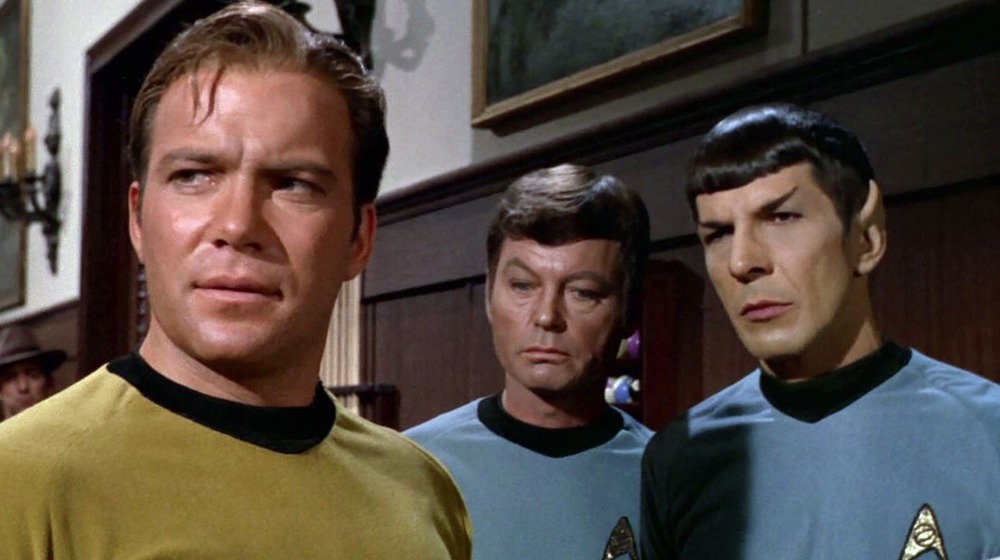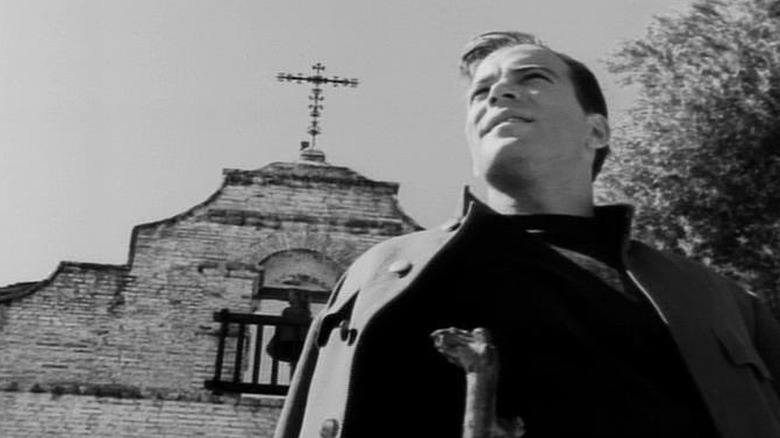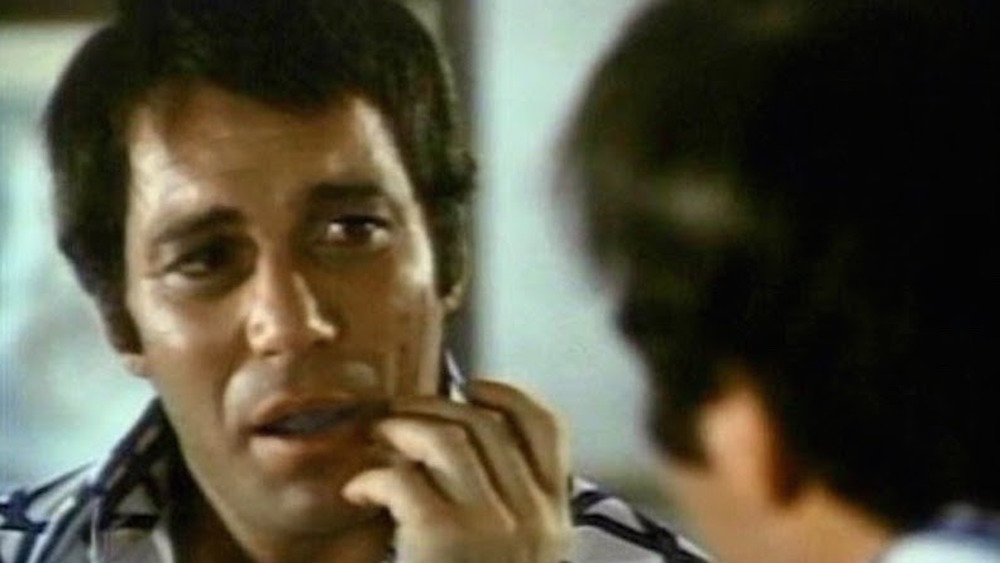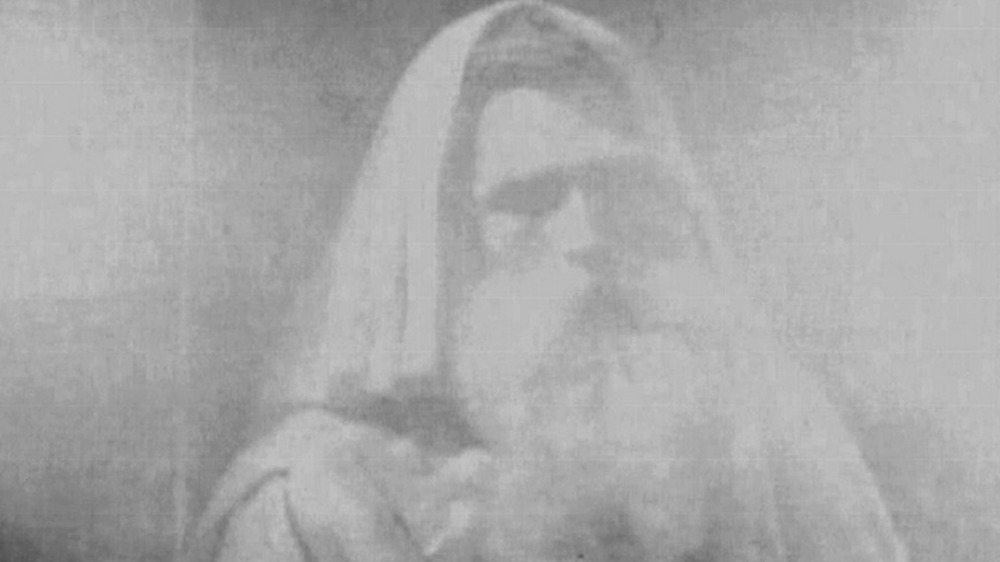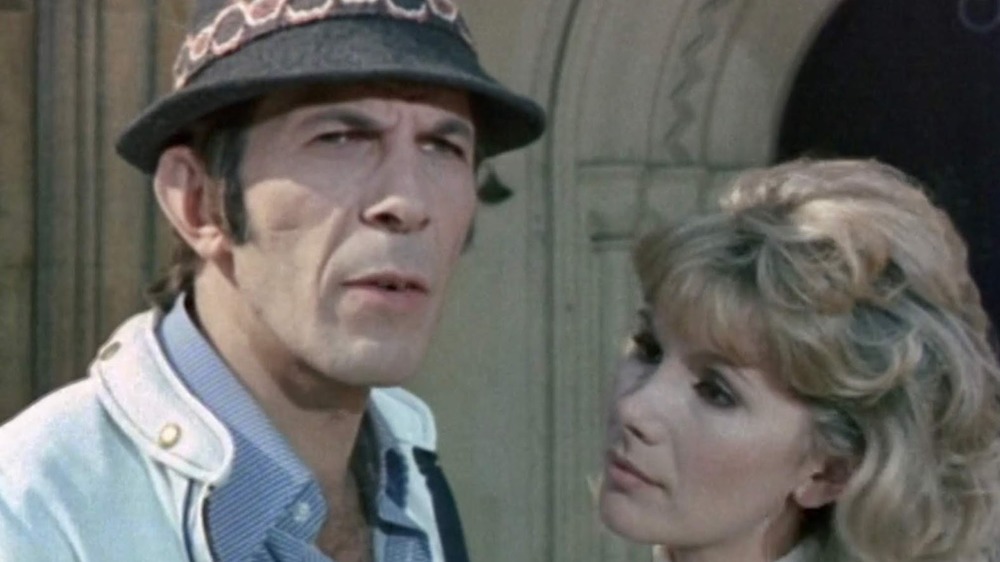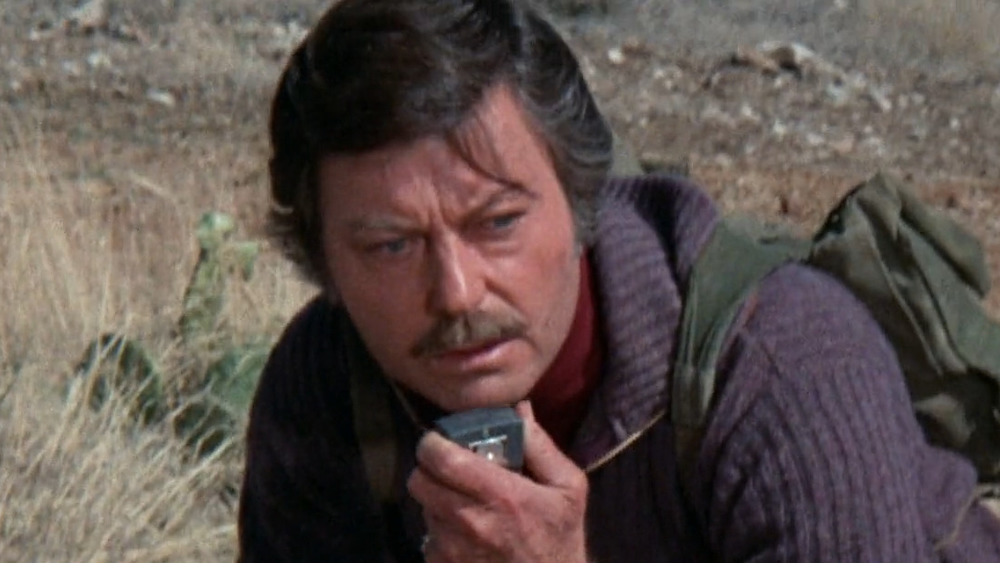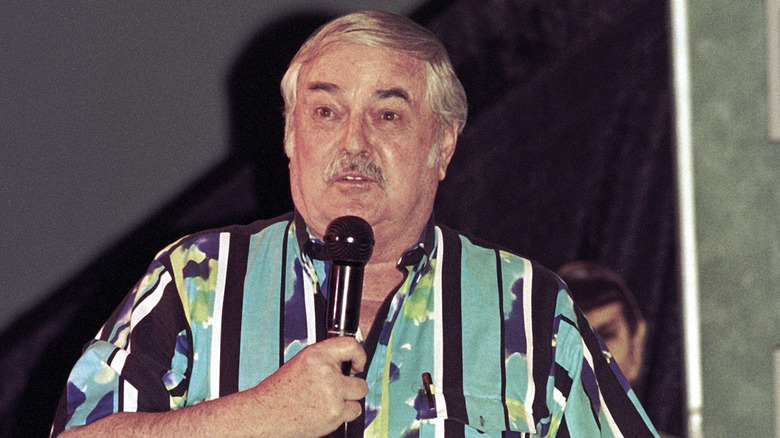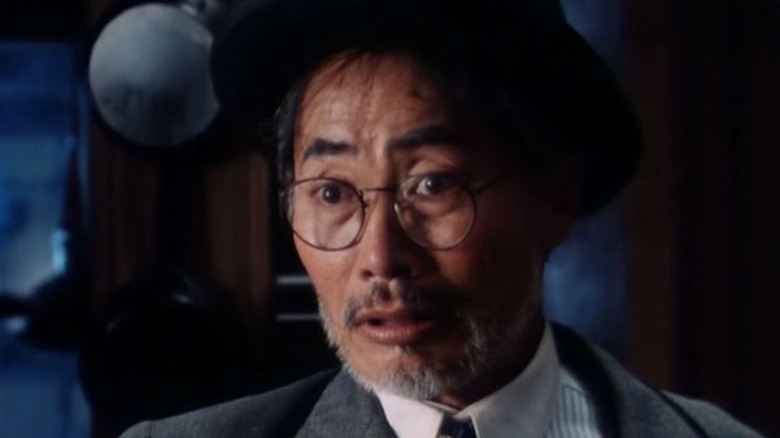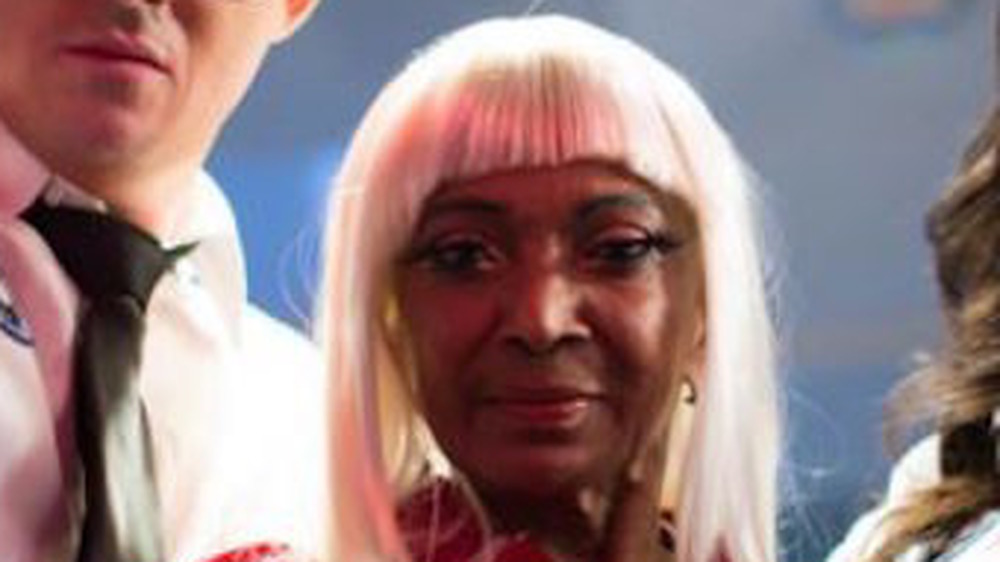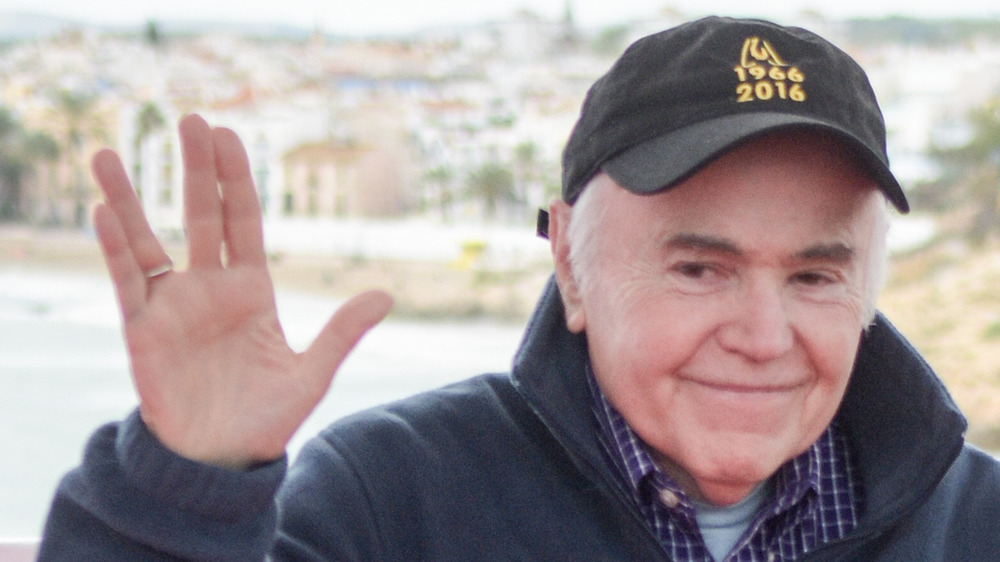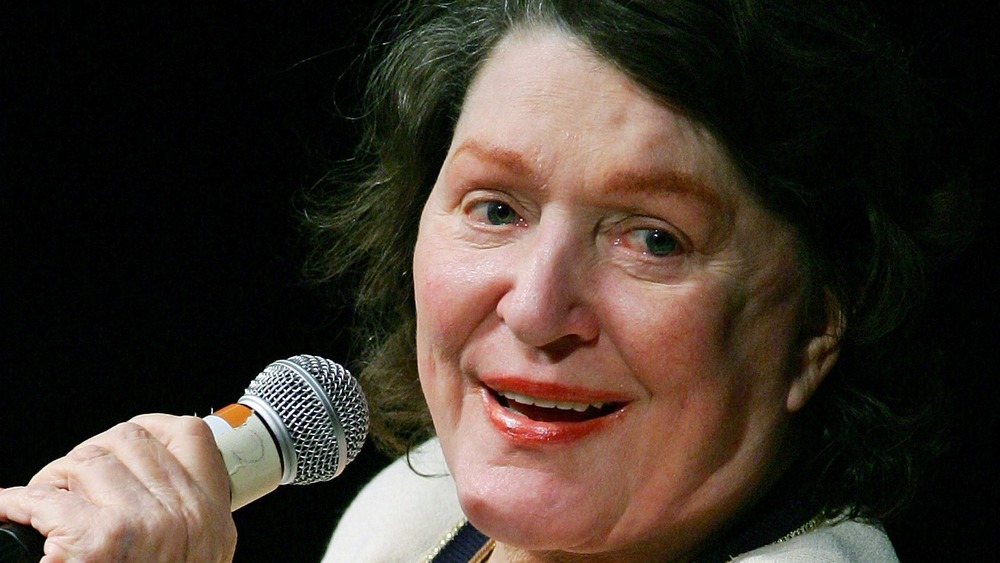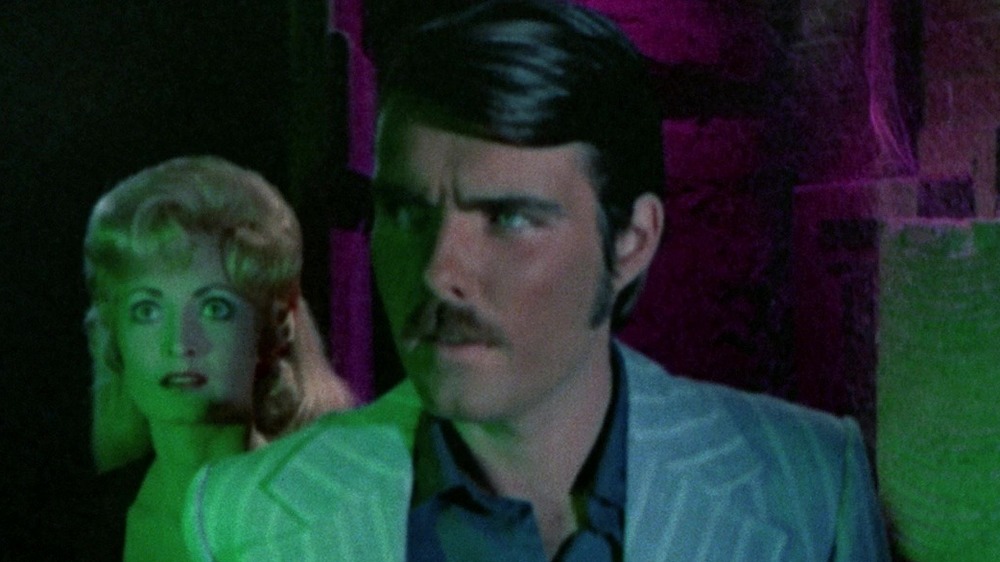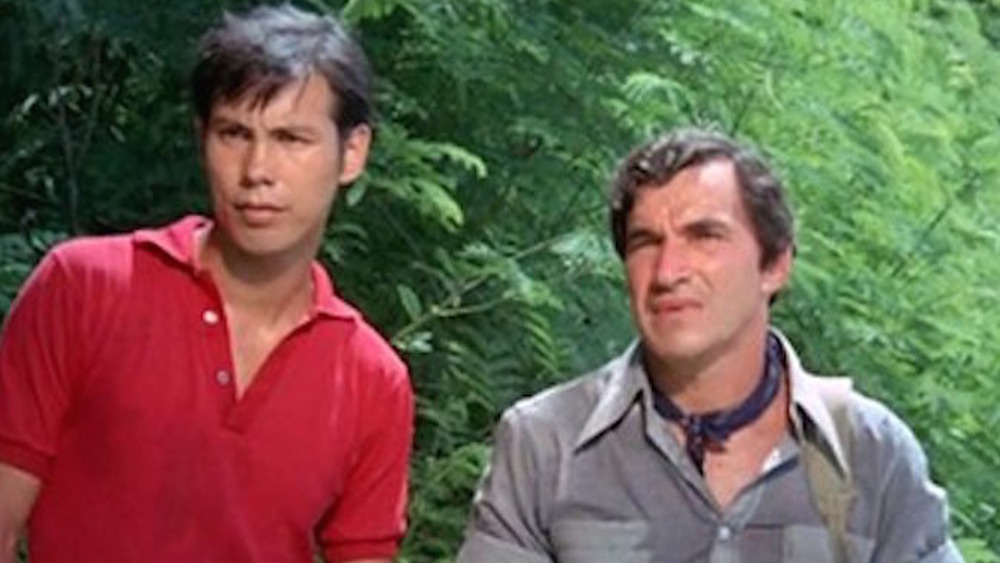Strangest Non-Star Trek Movie Appearances By The Original Series Cast
We may receive a commission on purchases made from links.
For every television actor who also manages to gain feature film stardom — think Tom Hanks, George Clooney, Jennifer Aniston, or Chris Pratt — there are countless others who remain firmly on the small screen. More often than not, the inability to transition has to do with luck: certain actors aren't able to find the project that gives them that boost onto the silver screen, or their feature efforts simply aren't welcomed with the same degree of open arms by audiences. Typecasting often has something to do with that glass ceiling, which is definitely the case with the cast of Star Trek: The Original Series.
Though not a ratings success during its three-year run, Trek was a huge hit in syndication. Yet most of the actors — including William Shatner, Leonard Nimoy, and DeForest Kelley, who had all been working for decades prior to Trek –- lacked an immediately identifiable screen identity outside of their roles on the series. As a result, all of them experienced typecasting to one degree or another (Shatner, Nimoy, and George Takei all managed to escape its bonds, but only after many years). In order to work, the Original Series cast sometimes found themselves in low-budget or independent features and series several rungs down from Trek on the prestige level. Some of these projects were mediocre, others just inept, and a few could be described as just plain weird. Let's boldly go now to investigate the strangest screen adventures of the original Star Trek cast and some of its recurring performers.
William Shatner - Incubus
William Shatner was a prolific actor before Star Trek, landing guest and recurring roles on series like The Twilight Zone, Thriller, and The Defenders, as well as feature films like Judgment at Nuremberg. But shortly before signing on to Trek in 1966, he earned the lead in Incubus, a surreal fantasy-drama from Outer Limits creator Leslie Stevens. The plot, about a magical well, the demon who haunts it (Stevens' then-wife, Allyson Ames), and the young soldier (Shatner) with whom she falls in love, is odd enough as it is, a sort of religious parable by way of European art film.
But what really sets Incubus apart is that the film's dialogue is entirely in Esperanto, a language created in 1887 as a universal second tongue for international speakers. Stevens chose Esperanto to foster an otherworldly atmosphere for the film — which already plays like a supernatural fever dream -– and while it proved effective in that regard, it failed to generate much interest from distributors (a mysterious rash of deaths among the cast didn't help word of mouth). Esperanto speakers also hated the film -– Shatner and the cast spoke the lines phonetically — and after a handful of screenings in France, Incubus disappeared from sight until 1993, when producer Anthony Taylor found a damaged print at the Cinematheque Francaise. Incubus has gone on to enjoy cult status on home video, but you won't find a copy in Shatner's collection. In his 2009 book Shatner Rules, he claims to have destroyed every copy of the film he's found.
Wiliam Shatner - Impulse
The 1970s were a lean period for Shatner. Typecast after Star Trek, he struggled to find lasting or significant work, and was forced to take any work that came his way, from appearances on episodic TV and game shows to low-budget features. A few of these have enjoyed a second life as "bad movie" favorites, like The Devil's Rain and Kingdom of the Spiders, while others have simply vanished. Somewhere between these is 1974's Impulse, a seedy psycho-thriller by veteran Florida-based director William Grefe.
Shatner, tricked out in a series of cornea-searing leisurewear, plays a deranged grifter with a taste for fleecing and then murdering his female marks. He meets his match in Tina (Kim Nicholas), the daughter of his latest target and something of a sociopath in training herself. Nicholas is memorably bratty, but Impulse is Shatner's showcase, and he throws himself into the project with manic glee, reveling in the character's cesspool of manias: his self-perceived machismo, gross pick-up lines (leveled at then-wife Marcy Lafferty, among others), lapses into infantilism (watch his fingers creep up towards his mouth in moments of stress), and full-blown rages. It's over-indulgent acting, to be sure, but you can't say that Shatner doesn't commit to the role.
Leonard Nimoy - The Brain Eaters
Like Shatner, Leonard Nimoy had worked steadily, if anonymously, until Trek vaulted him to stardom. Many of his early credits were minor or low-budget titles, including the 1952 series Zombies of the Stratosphere, which marked Nimoy's first appearance as an extraterrestrial. Six years later, Nimoy made a brief appearance in another science fiction feature, the 1958 microbudget thriller The Brain Eaters. Directed by actor Bruno Ve Sota –- a familiar face to fans of '50s-era films –- and distributed by Roger Corman, Eaters concerns a small town overrun by creatures from the center of the Earth that take over the bodies and minds of the residents (but, it should be noted, don't eat brains).
Given its budget (reportedly $26,000), Ve Sota brings a surprising amount of suspense and atmosphere to the project, but it's all undone by the special effects design for the creatures, which were reportedly toy ladybugs covered with fur cut from an old coat and pipe cleaners. As for Nimoy, he only appears for a moment in the film's conclusion, where he's hidden by fog and buried under old-man makeup as a former professor who serves the creatures. Given the end result, he was probably okay with the fact that the producers misspelled his last name in the credits.
Leonard Nimoy - Baffled
For Nimoy, the 1970s were a less tumultuous period than for some of his co-stars. Despite the title of his 1975 autobiography – I Am Not Spock, which mistakenly inferred that he disliked the fame afforded him by playing Science Officer Spock on Star Trek – he had a relatively easy relationship with the role, and enjoyed higher-profile film and TV work than Shatner or many of the other cast members. Those included a two-year stint on Mission: Impossible, hosting duties on the well-loved paranormal series In Search Of, and his directorial debut with an episode of Night Gallery.
But starring roles still eluded him, though not for trying. Case in point: Baffled!, a 1973 pilot for NBC with Nimoy as a race car driver who teams with a paranormal investigator (Susan Hampshire) to uncover the source of his psychic visions, which include a glimpse of his own demise. Produced in England by ITC Entertainment, Baffled! has a few moments of shivery suspense, but mostly struggles to sell Nimoy as a cool driver/ladies' man. Nimoy had considerable screen presence, but rarely as a chick magnet, and his garish wardrobe — which comes close to Shatner's get-up in Impulse – certainly doesn't help matters.
DeForest Kelley - Night of the Lepus
A busy actor in features and on television from the 1940s through the 1970s, DeForest Kelley was best known outside of Trek circles for his roles in Westerns, including a turn as Morgan Earp in 1957's Gunfight at the O.K. Corral. But the success of Trek essentially cemented Kelley as Dr. McCoy in the minds of viewers, and like several of his castmates, he was relegated almost solely to Trek-related projects for the next four decades until his death in 1999.
His one non-Trek feature film appearance during this period was in 1972's Night of the Lepus, a nature-gone-amok thriller produced by A.C. Lyles, who cast Kelley as the bad guy in several low-budget Westerns for Paramount in the 1950s. Lepus is well remembered among the bad film faithful as the first and only film (for very good reasons) about rabbits made huge and homicidal by experimental hormones, and for inspiring peals of laughter from audiences. Kelley — sporting an impressive mustache — has only a supporting role as a college professor in the film, and as such, manages to emerge from the project with most of his dignity intact.
James Doohan - Storybook
Despite his sizable c.v. of film and television roles, James Doohan found it nearly impossible to escape from the long shadow of Scotty in the post-Trek years. Even non-Trek projects like the ghastly Loaded Weapon 1 tapped him to utter an iconic line for gag purposes; as a result, Doohan –- a capable character actor with considerable vocal talents (check out Star Trek: The Animated Series, where you'll hear him voice two to three characters per episode) — turned to TV or low-budget films for work. Most of these efforts were forgettable, though 1996's Storybook stands out by virtue of its oddball cast and eccentric flourishes.
Essentially a budget-conscious riff on fairy tale fantasies like The Princess Bride and The NeverEnding Story, Storybook follows a young boy's journey in a magical land, where he battles an evil queen (Swoosie Kurtz) to save an imprisoned prince (former teen heartthrob William McNamara). Director Lorenzo Doumani — now a Las Vegas real estate developer — has plenty of enthusiasm but eccentric taste in casting: populating his fantasy land are magician Milton Berle; talking kangaroos and owls (the latter voiced by Ed Begley, Jr.); Richard Moll (Night Court) as a woodsman who gets in a fistfight with a fish; and as the hero's family, Jack Scalia, Doumani's former wife, Brenda Epperson, and Doohan as Uncle Monty. Trek faithful will note that the character's name is yet another Scotty joke playing off the character's full name (Montgomery Scott).
George Takei - Oblivion
Between his run as Sulu on Trek and his second act as an activist, author, and social media superstar, George Takei enjoyed (and continues to maintain) a steady profile of guest appearances on television series. His feature film output during this period was largely dominated by the Trek features with the Original Series cast and, like many of his co-stars, offbeat independent and low-budget features like 1994's Oblivion.
Released by Full Moon Pictures — the studio behind the Puppet Master and Trancers franchises – Oblivion is a sci-fi spin on a classic Western, pitting the sheriff of a frontier town on another planet against a one-eyed, reptilian bandit (Andrew Divoff). Director Sam Irvin (a co-producer of Gods and Monsters) and scripter Peter David (Babylon 5) steer the film's tone somewhere between nostalgia and broad comedy. The latter element is best personified by Takei as the town's drunken doctor, who, at one point, uncorks a bottle and exclaims, "Jim, beam me up!" Takei returned for more yucks in the 1996 sequel, Oblivion 2: Backlash.
Nichelle Nichols - Unbelievable!!!
Nichols, who played Lt. Uhura in the Original Series, maintained a lower post-Trek screen profile than many of her castmates, preferring instead to focus on her singing career, producing, and work with NASA as a recruiter. But prior to her retirement for health reasons in 2018, Nichols logged guest roles on several series like Heroes, as well as a brief appearance in Unbelievable!!!, a long-gestating, Naked Gun-style comedy that features more than 40 actors with Trek pedigrees in supporting and cameo roles.
Lensed in 2016 but unreleased until 2020, the film concerns an invasion of Earth by hostile plants, which is met by a rescue mission anchored by Snoop Dogg (as a military commander) and a marionette (designed by the Chiodo Brothers of Killer Klowns from Outer Space fame) that bears a strong resemblance to William Shatner. Nichols — who plays Aunt Petunia — Walter Koenig, Gary Lockwood (2001: A Space Odyssey) and Sean Kenney are among the players representing the Original Series, while Robert Picardo, Marina Sirtis, Nana Visitor, and Chase Masterson are among the many Trek franchise players enjoying (one hopes) an opportunity to play for laughs.
Walter Koenig - Blue Dream
After two seasons as Pavel Chekov on the Original Series, Walter Koenig enjoyed a diverse, multi-hyphenated career as a guest star in both Trek-related (Deep Space Nine) and non-Trek television and films, as well as numerous writing credits, including scripts for Land of the Lost and Star Trek: The Animated Series, several books, and graphic novels. Like his co-stars, his film projects outside the Trek universe have hewed towards indie genre efforts with cult appeal: several collaborators with Battlestar Galactica star Richard Hatch, 1989's Moontrap with Bruce Campbell and 2007's Bone Eater with Bruce Boxleitner.
And then there's 2013's ultra-obscure Blue Dream, a hazy zeitgeist drama that may or may not be about the collapse of print media and the rise of the internet (there's a lot of racy content and violence in the movie, too, which tend to further obfuscate what might be going on). The cast, which includes James Duval and Dominique Swain, does what they can to make sense of things, but Koenig, as a wealthy businessman, appears to be having a good time, as his Depression Era tough-guy patter would seem to indicate.
Majel Barrett - Mommy
The second wife of Trek creator Gene Roddenberry, actress Majel Barrett was perhaps best known for a recurring role on the Original Series as Nurse Christine Chapel, as well as the voice of Federation starship computers on several subsequent Trek series and movies, including a posthumous vocal role in J.J. Abrams' 2009 reboot. But Barrett had been appearing in features and on television since the late 1950s, and continued to work in character roles between Trek projects until her death in 2008.
The most eclectic of these is undoubtedly Mommy, a 1995 independent thriller written and directed by the extraordinarily prolific mystery and comic book author Max Alan Collins. Patty McCormick, who rose to fame as a malevolent child in 1956's The Bad Seed, stars as an overachieving mom whose ruthless need for her daughter's success leads her to murder anyone who stands in their way — including the girl's teacher (Barrett), whom McCormick pushes off a ladder after she refuses to award her kid the top pupil prize. Deliriously pulpy and featuring a truly offbeat cast — playwright and Exorcist star Jason Miller, '50s detective writer Mickey Spillane, scream queen Brinke Stevens – Mommy was an unexpected hit on cable and led to a 1997 sequel, Mommy 2: Mommy's Day.
Sean Kenney - The Corpse Grinders
Trek diehards know Sean Kenney from three Original Series episodes: in "The Menagerie," he's concealed by layers of makeup as the paralyzed and disfigured Captain Christopher Pike, while in "Arena" and "A Taste of Armageddon," he played helmsman/navigator Lt. DePaul. Between Trek assignments, Kenney — who continues to act and penned a memoir, Captain Pike Found Alive!, in 2012 — worked on television and in a slew of low-budget exploitation films. Many of these would qualify for this list, like Savage Abduction, The Manson Massacre, and The Toy Box, but the weirdest of the lot is unquestionably The Corpse Grinders.
Directed in 1971 by cult filmmaker Ted V. Mikels, who specialized in bizarro drive-in features like The Astro-Zombies, the film concerns the owners of a cat food company who discover that dead people are an effective, cost-cutting substitute for their product (!). Kenney is cast as the heroic veterinarian who uncovers their scheme when cats start attacking their owners. A popular title among psychotronic diehards, it's more ridiculous than disgusting, as evidenced by its corpse-grinding machine — a ramshackle pile of gears and cardboard boxes into which an actor is inserted, and which produces a pile of what appears to be raw hamburger meat.
Mark Lenard - Noon Sunday
Actor Mark Lenard was perhaps best known in the Trek universe for playing Sarek, the father of Spock, in the Original Series and four feature films with the OS cast. He's also the only actor in Trek history to play members of its three prominent alien races (in addition to Sarek, he played a Romulan in the OS episode "Balance of Terror" and a Klingon captain vaporized by V'ger in Star Trek: The Motion Picture). Lenard also maintained an impressive resume of theatrical performances and guest roles in episodic television throughout the 1960s and 1970s.
His feature film roles included character roles in Hang 'Em High and Annie Hall, as well as the co-lead in the obscure 1970 actioner Noon Sunday, which had the distinction of being one of the first feature films shot on the U.S. island territory of Guam. Lenard and 1950s TV cowboy John Russell star as mercenaries hired to assassinate a corrupt military leader. Both grimace convincingly while expending major firepower, but Noon Sunday is unremarkable drive-in fare, and makes little to no use of Lenard's sage, sympathetic screen presence.
